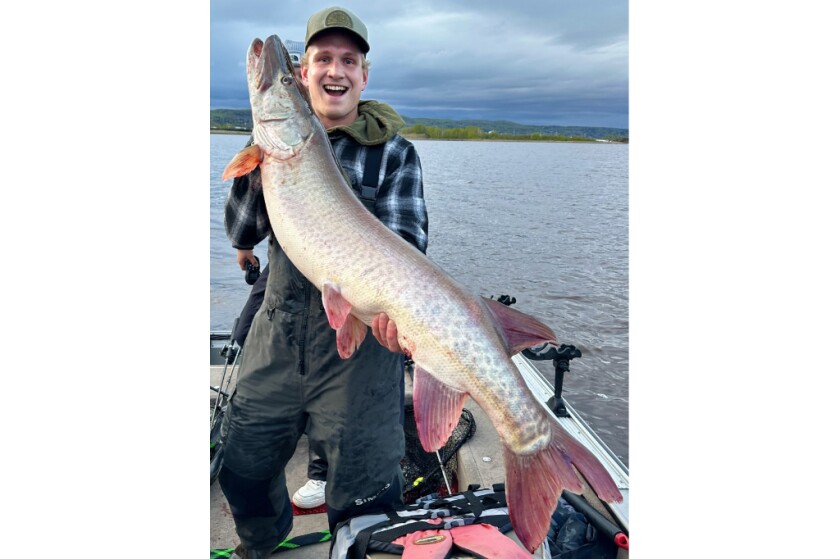BABBITT — A fishing boat cruised across Bear Island Lake on July 3 to an undisclosed honey hole where Joe Kane, head of design at Vexilar, planned to test out some of the fishing sonar electronics company’s newest equipment prototypes.
Each year, Kane visits YMCA Camp Northern Lights near Ely for a weeklong vacation with his wife’s family. This year, the trip doubled as an opportunity to do some work outside the office.
ADVERTISEMENT
“My wife's a big Boundary Waters person, and she went to Camp Warren growing up," Kane said. "So this is a way for them to continue the tradition of going to camp.
"There's something about catching your own food and cooking it up and it just makes it taste better," he said. "When we go up the Boundary Waters, being able to rely on that skill to actually eat feels really valuable. I'm looking forward to passing it on.”
Through the experience of camp, their 1 1/2-year-old son is also learning to share the enjoyment of being outdoors with family to carry on the tradition.

“I'm sure by this time next year he'll be reeling them in,” Kane said. “Fishing also introduces you to a lot of other useful skills, like how to run a motor, tying lots of knots and how to keep minnows alive. There's a lot of ancillary things that come with fishing, cleaning and cooking.”
Born and raised in St. Paul, Kane grew up fishing around the state, country, internationally and beyond North America with his father, who often used Vexilar equipment to help find the fish.
In the 1960s, Vexilar released the first neon flasher to provide an audible alarm with its 120 SOS model. In 1989, Vexilar reentered the depth finder market with the reintroduction of the FL-8 color flasher.
“My dad’s a die-hard fisherman,” Kane said. “For winters, I spent a lot of time listening to the hum of that FL-8. I actually have one of the old units — the same one I grew up with, on a shelf above my desk. I’ll just turn it on sometimes. It’s like a white noise relaxation. I took a lot of naps in the ice house to that hum.”
ADVERTISEMENT
Not only has fishing taught Kane patience after being “skunked” more than a few times, but in adulthood, he’s learned to unplug, relax and absorb the surrounding environment.
The opportunity to work for Vexilar was a “dream come true” job for Kane, and is a big source of pride for his father as they continue to bond over a favorite shared lifelong hobby.
What’s something that people need that’s not out there currently? That’s the ideal place to start.
Starting as a contracted user interface and user experience employee for Vexilar in June 2024, Kane was brought on full time as the head of design in October. Before that, he worked for a telecommunications platform that used a 360-degree camera for remote meetings, and he later did user interface freelancing.
“Industrial design was my calling,” said Kane, who dreamed of being an inventor as a child. “So I started out in engineering at the University of Minnesota, and did that for three years, until I decided that it wasn’t scratching the creative itch.”
Kane returned to school to study industrial design in California. There, he gained strong iteration skills by continuously testing out prototypes until they were fine-tuned enough to become a finished product.
Kane’s career evolved with the realization that he wanted more involvement in the user experience than simply making things that other people designed. Now, as a designer, Kane finds that his background in engineering aids in working efficiently alongside the other engineers at Vexilar.
There are some prototyping capabilities at the headquarters office, but it isn’t uncommon for him and his colleagues to take to the great outdoors on numerous occasions to test future products.
ADVERTISEMENT
During the product development process, the Vexilar team first identifies a gap in the outdoor recreational market, followed by researching and gathering feedback from pro staff or others in the industry who help test products and determine potential features.
“What’s something that people need that’s not out there currently?” Kane said. “That’s the ideal place to start.”

Since the company was originally founded in 1960, Vexilar has become a household name for many anglers across the Midwest and beyond. While it got its start releasing a small range finder for golfers, the fishing equipment company is best known for its flasher sonar technology.
“That’s kind of our ‘bread and butter,’” Kane said. “That’s a fish finder that is primarily used for ice fishing, but we’ve got plenty of people that are using them on boats as well. They really love the kind of durability, reliability, ease of use and how fast it is.”
Since the COVID-19 pandemic, ice fishing has been steadily gaining popularity, even following a few years of winters with bad ice conditions, Kane said. Sales reflected this trend.
“It's a little tricky being so seasonal as a company," Kane said, "but we definitely see that it's still a growing industry. There's still more and more people getting into it."
Just as the flasher was the product of its day, forward-facing sonar, or FFS, products are gaining momentum and becoming a hot trend in the industry.
ADVERTISEMENT
Also known as live sonar, an FFS provides anglers a real-time view of fish and structures beneath the water’s surface surrounding the boat to help target fish of a certain species and size more effectively, as opposed to historical data provided by a traditional sonar.
“Those are certainly competing for Vexilar dollars these days,” Kane said. “Humminbird, Garmin and Lowrance are the three big ones in terms of live view.”
While the competitors each specialize in different things, none are as synonymous with ice fishing as Vexilar’s flasher, according to Kane.
“In my opinion, to go ice fishing, you need an ice auger, a rod and a Vexilar,” Kane said. “If I had to get rid of one of those, I'd probably get rid of the auger and find a way to chisel through the ice.”
Upon its introduction in the 1980s, the flasher experienced similar hurdles as FFS currently faces as technology continues to advance. There are concerns surrounding the use of FFS and its impact on the sport’s integrity, fairness and potential effects on fish populations.
“With any new tech that comes out that gives you an upper hand, there's going to be a bit of controversy around it,” Kane said. “It's going to be really difficult to keep people from using the technology, so we're going to have to approach it from a regulations standpoint, making sure that people aren't abusing that power.”
Minnesota does not have any state regulations banning or restricting FFS, but different approaches are being discussed at the legislative level. Kane could not disclose whether Vexilar would be impacted, or whether the company is involved with lobbying, as it looks to the future of product development.
ADVERTISEMENT
The Minnesota Department of Natural Resources is monitoring the FFS technology’s impact and considering potential regulations, such as overseeing limitations on the amount of FFS units an angler can have on their boat, or by limiting the size and number of fish kept, particularly for muskellunge.
“We want to do what we can to protect our fishing waters, so we're careful when we're designing, making sure we're trying to use sustainable processes and creating products that are sustainable,” Kane said.


















